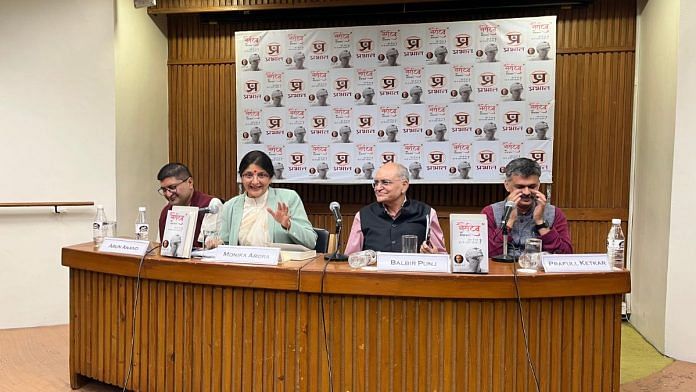New Delhi: A recent discussion on former BJP MP and columnist Balbir Punj’s book Narrative Ka Mayajaal turned into a gathering of parents worried about their children who, according to them, are being corrupted at schools and colleges propagating a particular ideology. And it was over an hour-long lament of how the Right doesn’t get it right, and loses the battle of narratives.
“From childhood till their old age, they (kids) are surrounded by dark clouds but they do not feel that the clouds are black. They think everything is trendy. It is not any one person or organisation that is working toward it. A tsunami is coming from all sides, which you call ecosystem,” said Supreme Court lawyer Monika Arora at a motley but thin gathering of people at the India International Centre (IIC) in Delhi.
The 20-odd guests included novelist and journalist Arun Anand, Prafulla Ketkar, Editor, Organiser Weekly and the author himself. The rest were the publisher’s staff and family members of the writer. More than half the chairs were empty and the audience didn’t need a mic to hear the speakers. It almost felt like a drawing room discussion.
The book Narrative Ka Mayajaal tries answering questions surrounding India’s identity — Was India not a nation before 15 August 1947? Are pluralism, democracy and secularism in India a gift given by foreigners? Did the British give us the shape of our country? Can the invaders be called nation builders? What is the truth of the two-nation theory?
Also read: UCC to Modi’s return in 2024, Delhi book launch discusses an ‘inevitable’ Hindu Rashtra
The missing ecosystem of the Right
Raising doubts on the quality of school education, Arora said, “What is taught at home starts changing in schools. There is a discussion in Indian families which is passed from generation to generation. But a discussion starts outside the home itself, which reaches the children. Perhaps our story is not presentable, it is not being written in his (the child’s) language and he gets attracted towards other stories.”
Citing the example of Ramayana, she said there is one Ramayana that is taught at home but when children step out, they learn 50 other versions; they come back and question their parents.
Rajguru, Bhagat Singh have been shown as extremists, it has been said that the Aryans came from outside, Arora said with a sense of lament.
Balbir Punj, who has also been a journalist and columnist, has authored Communists & Jihadis at Work in JNU, also published by Prabhat Prakshan.
“They catch people young, they train them ideologically in college. They have great domination in academics. We haven’t been able to develop the same ecosystem. We are not able to gather non-Left together. Because they are so marginalised in the journalistic, academic and intellectual world,” said Arun Anand.
Also read: Delhi durbars flaunted the might of British Crown. They also stoked flames of resistance
The British blame
After talking about the ‘the strong narrative’ the discussion soon moved to caste and Hinduism and one of the speakers claimed that casteism did not exist in old India, and it was the Britishers who brought it.
“Casteism did not exist in old India. When the British came, all this also came. It is not known that those whom we call SC today had any hindrance in their education. Vedic education was limited to the Brahmins that was mainly in either homeschooling or religious school,” said Prafulla Ketkar.
But according to a British document, skill-based education has no discrimination, he said. English education created the caste narrative. This is a sensitive issue so no one touches it politically, Praful added.
Also read: Delhi celebrates ‘Rang de Korea’ with live K-pop, freebies. But diehard fans were disappointed
‘Learning from the Left’
Commenting on the pattern of campus agitation and how protests rapidly spread at institutions, Arora said, “They follow a baton race pattern in their thought process. If there is an issue in the JNU campus and students start the strike, professors also start supporting it and in one night, they prepare the petition. Next day, ex-law ministers are coming into the courts fighting the matters and by evening, the matter is being reported in the online portals. It is a common phenomena. They are passing the baton,” said Arora.
More than the book, it became an ‘us vs them’ discussion that focused on how there is so much to learn from the Left ecosystem. Except the speakers held a sense of disdain for that “ecosystem”.
(Edited by Anurag Chaubey)



